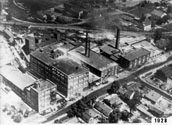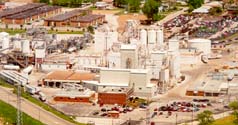Quality Products



Carondelet Plant History
The Solutia Carondelet Plant is located on nineteen acres in the south St. Louis community of Carondelet. The area is a mixed commercial and residential community, with apartments, small residences, and numerous small businesses located in close proximity to the plant’s fence line. A channelized stream, the River des Peres, flows to the south of the plant, emptying into the Mississippi River about one mile east of the plant.
The Carondelet community was founded in 1776 by French and Creole settlers, 5 miles south of the settlement of St. Louis. The region was under the control of the Spanish government, later becoming French, and then becoming a part of the United States in 1803 with the Louisiana Purchase. The area developed as a rural working class/farming community, and later also became a site for the “country homes” of wealthy St. Louisans. By 1870, Carondelet village had been incorporated into the city of St. Louis.
The Carondelet area has a long history of industrialization, beginning in the late 1840’s with lead refining and the manufacturing of lead shot. At the same time, the Iron Mountain railroad line was established and ran through the area transporting iron ore from southwestern Missouri to the developing St. Louis iron industry. During the Civil War, the Carondelet shipyard manufactured 32 ironclad gunships for the Union Army.
Information about the history of the current Carondelet Plant site dates from about 1870. Between 1870-1930, Hertz Metal Company operated a lead smelter at the present acid plant location. Hertz also produced bailing wire. During the 1870’s, an iron foundry was located on the north side of Weber, with an iron smelter that was located northeast of the lead smelter.
In 1876, Provident Chemical Works established a “salt flats” plant at the site of the present plant, south of the MOPAC railroad tracks. From the 1876-1912 this plant manufactured phosphoric acid by acidulating bone black with sulfuric acid and concentrating the acid in lead pans. Phosphoric acid was reacted with lime to manufacture monocalcium phosphate (MCP). Provident Chemical also manufactured sulfuric acid on site from elemental sulfur or sulfur bearing materials. By the turn of the century, Provident Chemical was a leader in phosphate manufacturing.
Throughout the 1800’s, until the 1920’s, the flood plains adjacent to the River des Peres were used for farming. This activity was gradually abandoned in the early 1920’s because of persistent flooding and the flood plains were then used for trash disposal by the City of St. Louis.
Between 1912-1921, as bone black became scarce, Provident Chemical began to manufacture phosphoric acid from phosphate ore. The first major plant expansion took place in 1917, when new buildings were built to house the new phosphoric acid operations. Nitric acid and sulfuric acid were also used and manufactured on site. A coal fired steam plant was used to supply power. In 1921, the electric arc furnace process of producing elemental phosphorus made a high grade of phosphoric acid commercially available, so Provident Chemical began to purchase phosphoric acid for phosphate chemical manufacture.
In the mid-1920’s, Provident Chemical was purchased by Swann Chemical
Company. Swann manufactured MCP, tricalcium phosphate (TCP), other
phosphate related compounds, starch, and acids.
In 1935 Monsanto Company purchased Swann chemical. Monsanto considered moving the former Swann operations to the W.G. Krummrich plant, but instead decided to modernize the existing operations at the “new” Carondelet plant. Monsanto continued to purchase phosphoric acid to manufacture a variety of phosphate compounds and added dicalcium phosphate anhydrous (DCPA) to the plant portfolio. In 1942, the plant was expanded to build facilities for a new leavener, Pyran.
Other business establishments continued to be located on portions of the present plant site. During the 1940’s, a packaging company was located on the present maintenance building site. They bottled trichloroethane, benzol, etc. for army usage. In 1944, the production, maintenance, warehouse and service employees became represented by ICWU Local 81. During the 1950’s, the Blackburn Company used the above site to copper plate lightning rods. In addition, the River des Peres ran through the site until it was rerouted by a WPA project about 1934-1935. When the River des Peres was rerouted, the old channel was backfilled and additional filling continued through about 1958.
During the 1950’s-1960’s, Monsanto gradually expanded into its current site, as space requirements increased and additional business opportunities developed. Due to the geology of the plant site, extensive filling was required in certain areas to allow for the expansion. The plant entered the detergent business in 1951 with the addition of the sodium tripolyphosphate (STP) department. Several phosphates were added in 1955; all were later discontinued with the exception of monopotassium phosphate (MKP). In 1963, the Carondelet plant began to manufacture a number of related leavening agents, all classified as sodium aluminum phosphates (SALP).
Throughout this period, for 36 years, the Carondelet plant continued
to purchase phosphoric acid for use in its expanding range of phosphate
manufacturing. In February 1971, a new acid plant was started up
to manufacture high quality phosphoric acid. In 1985, a major modification
was made to the acid plant to recover the heat generated from burning phosphorus.
This heat is used to produce steam and to supply energy to the rest of
the plant’s manufacturing units. Modifications, upgrades, and improvements
continue to be made throughout the plant, from MCP to Maintenance, Pyran,
the NaK and Calcium packaging areas, and training. Operations have
changed as well, from “hands-on” field operated equipment to control rooms
where automatic production equipment is operated from control panels and
computers.
On September 1, 1997, Monsanto spun off the chemical segment which became a new company - Solutia Inc. The Phosphorus & Derivatives part of the business of which Carondelet is a member, became a part of the new company.
The Carondelet Plant, as part of Solutia Inc. continues to be a leader in phosphate and phosphoric acid manufacturing. The current plant produces over 250 million pounds per year, in six major production units: Phosphoric acid; STP, MKP/DKP; TCP/TMP; MCP; and Pyran/SALP.
The Carondelet Plant became part of a Joint Venture in April of 2000
between FMC and Solutia. The new company is named Astaris, LCC. The new
company will specialize in Phosphates and Derivatives.

